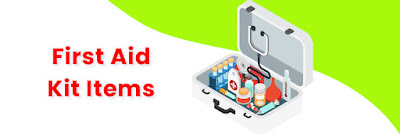Top 10 First Aid Kit Items
First Aid definition - When you give first aid to someone who has had a sudden illness or accident, you are providing medical treatment.
Local pharmacies stock ready-to-use first-aid kits that come in helpful in an emergency. You may either buy it or create your own. A first aid kit should be kept in your home, car, and office at all times.
A basic first aid kit should have:
- safety pins
- antiseptic cream
- small, medium, and large sterile gauze dressings
- cream or spray for relieving insect bites and stings
- thermometer
- skin rash creams like calendula or hydrocortisone
- crepe bandages (rolled)
- plasters
- disposable sterile gloves
- tweezers
know more Basic steps for emergencies and the Importance of a first aid box.
Tag - types of first aid; class 5th EVS first aid; safety and first aid class 5 worksheet; first aid class 5 note; school online class

Comments
Post a Comment
Thank you we will contact ASAP.